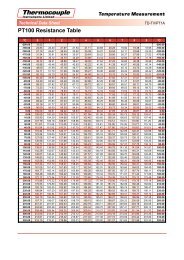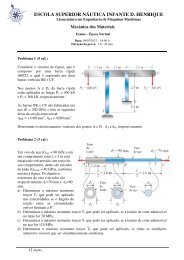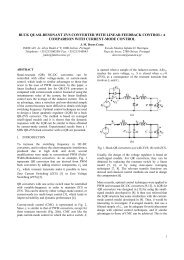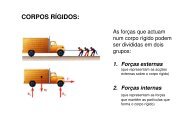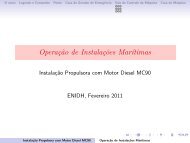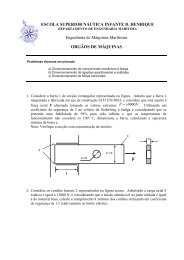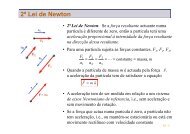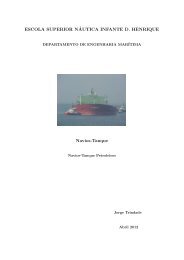Textos de Apoio (pdf)
Textos de Apoio (pdf)
Textos de Apoio (pdf)
Create successful ePaper yourself
Turn your PDF publications into a flip-book with our unique Google optimized e-Paper software.
15.0 knots<br />
115% power<br />
B<br />
Power<br />
B´<br />
15.0 knots<br />
115% power<br />
Slip<br />
Power<br />
B<br />
12.3 knots<br />
100% power<br />
15.0 knots<br />
100% power<br />
Slip<br />
D´ D A<br />
Power<br />
15%<br />
Sea<br />
margin<br />
15.6 knots<br />
115% power<br />
Propeller curve for clean<br />
hull and calm weather<br />
15%<br />
Sea<br />
margin<br />
15.6 knots<br />
115% power<br />
Propeller curve for clean<br />
hull and calm weather<br />
Propeller<br />
curve for<br />
fouled hull<br />
and heavy<br />
seas<br />
10.0 knots<br />
50% power<br />
Propeller curve<br />
for clean hull and<br />
calm weather<br />
A<br />
(Logarithmic scales)<br />
15.0 knots<br />
100% power<br />
Ship speed<br />
A<br />
(Logarithmic scales)<br />
15.0 knots<br />
100% power<br />
Propeller speed<br />
C<br />
HR<br />
LR<br />
(Logarithmic scales)<br />
12.3 knots<br />
50% power<br />
HR = Heavy running<br />
LR = Light running<br />
Propeller speed<br />
Fig. 12a: Ship speed performance at 15%<br />
sea margin<br />
Fig. 12b: Propeller speed performance at<br />
15% sea margin<br />
Fig. 12c: Propeller speed performance at<br />
large extra ship resistance<br />
Sometimes, for instance when the hull<br />
is fouled and the ship is sailing in heavy<br />
seas in a head wind, the increase in<br />
resistance may be much greater, corresponding<br />
to an extra power <strong>de</strong>mand<br />
of the magnitu<strong>de</strong> of 100% or even higher.<br />
An example is shown in Fig. 12c.<br />
a ducted propeller, the opposite effect<br />
is obtained.<br />
Heavy waves and sea and wind against<br />
When sailing in heavy sea against, with<br />
heavy wave resistance, the propeller<br />
can be up to 7-8% heavier running<br />
than in calm weather, i.e. at the same<br />
propeller power, the rate of revolution<br />
may be 7-8% lower. An example valid<br />
for a smaller container ship is shown in<br />
Fig. 13. The service data is measured<br />
In this example, where 100% power<br />
will give a ship speed of 15.0 knots,<br />
point A, a ship speed of, for instance,<br />
12.3 knots at clean hull and in calm<br />
weather conditions, point C, will require<br />
about 50% propulsion power but, at<br />
the above-mentioned heavy running<br />
conditions, it might only be possible to<br />
obtain the 12.3 knots by 100% propulsion<br />
power, i.e. for 100% power going from<br />
point A to D. Running point D may now<br />
be placed relatively far to the left of point<br />
A, i.e. very heavy running. Such a situation<br />
must be consi<strong>de</strong>red when layingout<br />
the main engine in relation to the<br />
layout of the propeller, as <strong>de</strong>scribed in<br />
Chapter 3.<br />
A scewed propeller (with bent bla<strong>de</strong><br />
tips) is more sensitive to heavy running<br />
than a normal propeller, because the<br />
propeller is able to absorb a higher<br />
torque in heavy running conditions. For<br />
C<br />
B<br />
A<br />
Extremely bad weather 6%<br />
Average weather 3%<br />
Extremely good weather 0%<br />
Clean hull and draught D<br />
D MEAN = 6.50 m<br />
D F = 5.25 m<br />
D A = 7.75 m<br />
Source: Lloyd's Register<br />
BHP<br />
21,000<br />
Heavy<br />
running<br />
18,000<br />
15,000<br />
12,000<br />
9,000 13<br />
6,000<br />
Shaft power<br />
C<br />
B<br />
16 A<br />
19<br />
Ship speed<br />
knots<br />
10%<br />
Apparent slip<br />
6%<br />
2%<br />
-2%<br />
22<br />
76 80 84 88 92 96 100<br />
r/min<br />
Propeller speed<br />
Fig. 13: Service data over a period of a year returned from a single screw container ship<br />
17


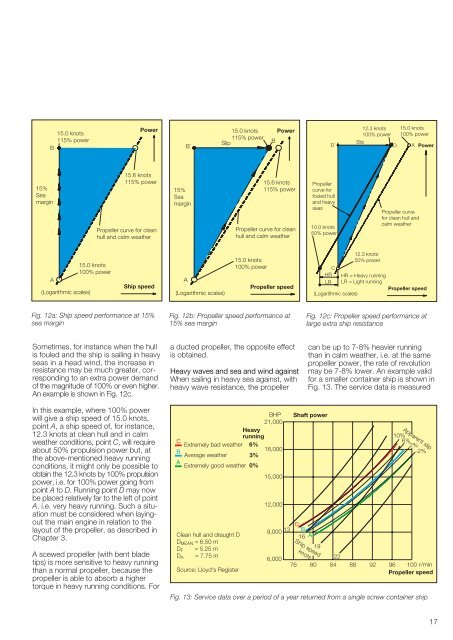
![Conceitos transmissao de dados .Sinais[.pdf]](https://img.yumpu.com/50982145/1/190x146/conceitos-transmissao-de-dados-sinaispdf.jpg?quality=85)
![Packages e interfaces[.pdf]](https://img.yumpu.com/50629553/1/190x134/packages-e-interfacespdf.jpg?quality=85)
